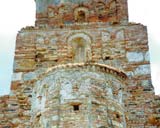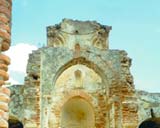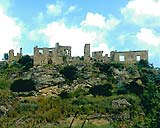|
Bova, Condofuri, Gallicianò, Roccaforte del greco, Roghudi can be
considered the centres that still present the most evident traces of
the magna Graecia culture. Calabrian greek, spoken in this places,
is an object of study and research, but also a reason of cultural
exchanges and initiatives to protect the historical linguistic
minorities. Bova, greek capital of Calabria, presents the ruins a
norman castle. It is at about 1000mt. above the level of water and
it’s reachable from the main road that starts in Bova Marina. The
cathedral keeps an old marble statue of the Madonna with the Baby,
of 1584, attributed to Rinaldo Bonanno. The ancient village of
Brancaleone Superiore (fief of noble calabrian families like the
Ruffo and the Scalea), stands on top of a cliff, shows the ruins of
the castle and the rests of the church dedicated to the Madonna
dell’Annunziata. Along the main road to Staiti there are, in the
Batia district, the remains of a byzantine-norman abbey (XI cent.)
dedicated to Santa Maria di Tridetti, and that was for almost a
millennium a centre of religious cult an popular pilgrimage.
The soul dance
The “viddenedda” has its origin in some rituals linked to the Magna
Graecia culture, with its liberating rythm and symbols that
underline the choreographical movements. Through the centuries the
dancing occasions were always linked to families festivities, the
agricultural one, in occasion for example of the harvest or the
thresh, or religious ones. The space of the dancing was decided and
then the master of the dance was chosen, and with gracious movements
decided who from the public had to get in and out of his area. There
was also the courting ritual, with intertwined gazes and
unmistakable movements. The melody of the viddanedda was given to a
small organ, an aerophone, and the rythm was given by a tambourine,
made out of a skin spread onto a simple frame of thin wood generally
of a round shape. To increase the sound, the tambourine enriched
with a double row of tin bells.
 |
|
 |
Santa Maria of Tridetti (outer shot)
Photo Archive Province of Reggio Calabria - Photo by: Alessia Campolo |
 |
|
|
Santa Maria of Tridetti (interior shot)
Photo Archive Province of Reggio Calabria - Photo by: Alessia Campolo |
 |
|
|
|
|
|
 |
|
|
Ruins of Brancaleone superiore
Photo Archive Province of Reggio Calabria - Photo by: Antonio Muzzupappa |
 |
|
|
|
|

